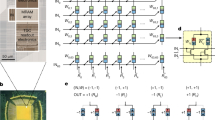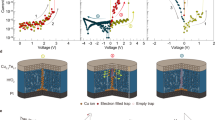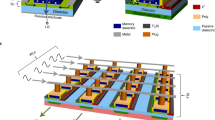Abstract
The development of transistor-based integrated circuits for modern computing is a story of great success. However, the proved concept for enhancing computational power by continuous miniaturization is approaching its fundamental limits. Alternative approaches consider logic elements that are reconfigurable at run-time to overcome the rigid architecture of the present hardware systems1. Implementation of parallel algorithms on such ‘chameleon’ processors has the potential to yield a dramatic increase of computational speed, competitive with that of supercomputers2. Owing to their functional flexibility, ‘chameleon’ processors can be readily optimized with respect to any computer application. In conventional microprocessors, information must be transferred to a memory to prevent it from getting lost, because electrically processed information is volatile. Therefore the computational performance can be improved if the logic gate is additionally capable of storing the output. Here we describe a simple hardware concept for a programmable logic element that is based on a single magnetic random access memory (MRAM3,4) cell. It combines the inherent advantage of a non-volatile output with flexible functionality which can be selected at run-time to operate as an AND, OR, NAND or NOR gate.
This is a preview of subscription content, access via your institution
Access options
Subscribe to this journal
Receive 51 print issues and online access
$199.00 per year
only $3.90 per issue
Buy this article
- Purchase on Springer Link
- Instant access to full article PDF
Prices may be subject to local taxes which are calculated during checkout



Similar content being viewed by others
References
Prinz, G. A. Magnetoelectronics. Science 282, 1660–1663 (1998)
Sidhu, R. P. S., Mei, A. & Prasanna, V. K. in Field-programmable Logic and Applications (eds Lysaght, P., Irvine, J. & Hartenstein, R. W.) 301–312 (Lecture Notes in Computer Science 1673, Springer, Berlin, 1999
Parkin, S. S. P. et al. Exchange-biased magnetic tunnel junctions and application to nonvolatile magnetic random access memory. J. Appl. Phys. 85, 5828–5833 (1999)
Grünberg, P. Layered magnetic structures: history, highlights, applications. Phys. Today 54, 31–37 (2001)
Baibich, B. N. et al. Giant magnetoresistance of (001)Fe/(001)Cr magnetic superlattices. Phys. Rev. Lett. 61, 2472–2475 (1988)
Binasch, G., Grünberg, P., Saurenbach, F. & Zinn, W. Enhanced magnetoresistance in layered magnetic structures with antiferromagnetic interlayer exchange. Phys. Rev. B 39, 4828–4830 (1989)
Moodera, J. S., Kinder, L. R., Wong, T. M. & Meservey, R. Large magnetoresistance at room temperature in ferromagnetic thin film tunnel junctions. Phys. Rev. Lett. 74, 3273–3276 (1995)
Black, W. C. Jr & Das, B. Programmable logic using giant-magnetoresistance and spin-dependent tunneling devices. J. Appl. Phys. 87, 6674–6679 (2000)
Richter, R. et al. Field programmable spin-logic based on magnetic tunneling elements. J. Magn. Magn. Mater. 240, 127–129 (2002)
Martin, A. J. Proceedings of SSGRR 2000, International Conference on Advances in Infrastructure for Electronic Business, Science, and Education on the Internet; at 〈http://www.ssgrr.it/en/ssgrr2000/papers/185.pdf〉 (2000)
Gerrits, Th., van den Berg, H. A. M., Hohlfeld, J., Bär, L. & Rasing, Th. Ultrafast precessional magnetization reversal by picosecond magnetic field pulse shaping. Nature 418, 509–511 (2002)
Motorola Inc. Press release. IEEE International Solid State Circuits Conference (San Francisco, June 2001); at 〈http://www.motorola.com/mot/document/content/0,1028,372,00.doc〉 (2000).
Goronkin, H., von Allmen, P., Tsui, R. K. & Zhu, T. X. Nanostructure Science and Technology (eds Siegel, R. W., Hu, E. & Roco, M. C.) 67–92 (National Science and Technology Council (NSTC) Committee on Technology and The Interagency Working Group on NanoScience, Engineering and Technology (IWGN), 1999); at 〈http://www.wtec.org/loyola/nano/05_01.htm〉 (1999). Copyright is held by: WTEC, Loyola College (Maryland)
Compañó, R. Technological Roadmap for European Nanoelectronics at 〈ftp://ftp.cordis.lu/pub/ist/docs/fetnidrm.zip〉 (2000)
Author information
Authors and Affiliations
Corresponding author
Ethics declarations
Competing interests
The authors declare that they have no competing financial interests.
Rights and permissions
About this article
Cite this article
Ney, A., Pampuch, C., Koch, R. et al. Programmable computing with a single magnetoresistive element. Nature 425, 485–487 (2003). https://doi.org/10.1038/nature02014
Received:
Accepted:
Issue Date:
DOI: https://doi.org/10.1038/nature02014
This article is cited by
-
Purely self-rectifying memristor-based passive crossbar array for artificial neural network accelerators
Nature Communications (2024)
-
Spintronics intelligent devices
Science China Physics, Mechanics & Astronomy (2023)
-
Implementation of 16 Boolean logic operations based on one basic cell of spin-transfer-torque magnetic random access memory
Science China Information Sciences (2023)
-
Anisotropic MagnetoMemristance
Communications Physics (2022)
-
Evidence for negative differential resistance and switchable diode effect in multiferroic BiFe0.95Sc0.05O3-based resistive random access memory under doping engineering
Journal of Materials Science: Materials in Electronics (2022)
Comments
By submitting a comment you agree to abide by our Terms and Community Guidelines. If you find something abusive or that does not comply with our terms or guidelines please flag it as inappropriate.



